Bridging Worlds: Connecting the Mystic with the Mundane
Bridging Worlds: The Power of Bridging the Mystic with the Mundane
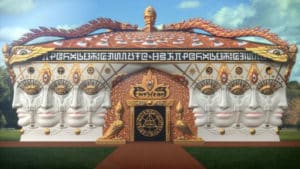
Would you like to have more epic lucid dreams? Would you like to know HOW having more lucid dreams helps you become a master Spirit World navigator, in addition to supporting your spiritual evolution?
Dreaming is an essential shamanic skill, as shamans are a bridge between both worlds, traditionally responsible for communication with Spirits and balancing earth energy, for the health & well being of the community. Dream practice will also strengthen your navigational skills in a plant medicine induced visionary state.
The practice of Tibetan Dream Yoga is a way that you can develop your conscious awareness so that you recognize all life as a dream, and are able to direct your consciousness with more skill while it is free of your physical body, in the dream state, as well as in the moment of death.
One of the key practices in Dream Yoga, is the practice of bridging dreaming life with waking life. In doing so, you are reminded that life is but a dream. When you are consciously aware of the dreamlike nature of experience, it is easier to be consciously aware in the dream state. One of the benefits to being consciously aware in the dream state is having epic lucid dreams.

The Link Between Lucid Dreaming & Enlightenment
In the practice of Tibetan Dream Yoga, lucid dreaming is one of the techniques that the Masters would practice in order to be able to navigate the Bardo realms after death. In fact, the Tibetans have a practice – the practice of Phowa – which is the transference of consciousness at the time of death. In Vajrayana Buddhism, Phowa practice is considered to be the quickest, most direct path to enlightenment.
Essentially, the practice involves transferring one’s consciousness through the top of the head directly into a Buddha-field of one’s choice, which allows the practitioner to continue their study of Dharma in a favorable, supportive, and divinely beautiful environment, surrounded by enlightened beings.
By so doing, one bypasses some of the typical experiences that are said to occur after death, such as being confronted by fearsome wrathful deities, which can result in a lower rebirth. As you run away from the wrathful deities and try to hide from them, the cave or house you seek shelter in ends up being the womb of your next mother. And thus repeats the cycle of rebirth.

Depending on your karmic circumstances, you might spiral down, rather than evolve up, taking on more karma, and more cycles of rebirth…until one day your practice is so strong that you are able to break free from the Wheel of Life as an enlightened being.
The practice of Phowa is serious and profound. As with any “short cut” spiritual practice, there are inherent dangers to the practitioner if they are mistaken in their understanding of the teachings or the practice. This is an advanced practice that should only be followed under the instruction of a Master.
However, Dream Yoga is a practice that is considerably more safe and fun. While studying with a Master can be immensely powerful, you can start on your own and follow some wonderful books on the topic. I’ve listed my favorites in the resource links below.
The 3 Cardinal Rules of Lucid Dreaming
While in the West, there is much more focus on lucid dreaming for entertainment purposes, because you can do “anything” in the dream state and not suffer “real” consequences, in Tibetan Buddhism, dream yoga is a sacred, spiritual practice.
Because energy moves more freely and quickly in the dream state, the Tibetans believe that karma (both positive and negative karmas) of body, speech and mind would also be accelerated.
Lucid dreaming can be easily used to perpetuate the problems you experience in waking life. For this reason, it’s important to follow these 3 cardinal rules of lucid dreaming, and maintain your integrity in the dream state as you would in waking life
- Avoid Harming Yourself. The great news is that it’s pretty hard to harm yourself in the dream state, even deliberately. But because your intrinsic nature is divine, do also respect, love, and honor your dream body.
- Avoid Harming Others. While killing other dream beings in the dream state is nowhere near as bad as killing a living, breathing being, it does leave the taint of negative karma, especially if this is done with malice (as opposed to self defense) or enjoyment of harming others. Even in a dream, can you try to get along and coexist in peace?
- Avoid Sexual Misconduct. Dream sex can be pretty fun, especially if your dream partner is hot and excited about it. But just because you are in a dream, doesn’t give you karma-free license to assault or rape the dream beings around you. Try “consent” – it works even in the dream state!
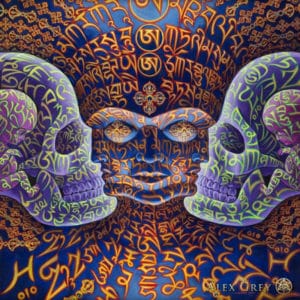
10 Lucid Dreaming Super Powers
The Tibetan Masters had specific goals they would pursue in the lucid dream state, goals that would strengthen their conscious awareness and accelerate their attainment of enlightenment. Even though many of these dreamstate attainments are fun and exhilarating, dream yogis did not engage in the sacred practice of lucid dreaming for entertainment!
Here are time-honored Dream Yoga attainments that will help you hone your dreaming skills, and give you freedom and empowerment in life.
- Flying. Flying in the dream state is the ultimate experience of freedom. Pay attention to how you fly. Do you sprout wings and soar like an eagle? Or do you find yourself doing the breaststroke through the sky? Can you fly in different ways?
- Shapeshifting. You can transform yourself into anything, such as your power animal, the opposite sex, your favorite superhero, or a fire-breathing dragon. Is there a particular dreamstate avatar that you assume? See how shapeshifting shifts your perspective on who you are and how you can be in waking life.
- Facing Your Fears. Have you noticed that if you find yourself being chased in the dream state, the more you try to get away, the scarier the dream becomes? Try turning around and face your pursuers. Chances are, you will discover that they aren’t so scary after all. In fact, they might just even vanish.
- Meeting Other Sentient Beings. Without physical distance separating you, you can potentially meet anyone you want. Or get to know the other dream people in your dreamscape. Or find your mission-aligned soul tribe and create a pact to try to meet in real life.
- Communicating with an Enlightened Being (Yidam). Encounters with divine beings in the dream state are highly sought after, and as with shamanic journeys, not uncommon. Try invoking the divine beings you are allied with and see what happens.
- Receiving Teachings, Empowerments & Transmissions. In addition to encounters with divine beings, you can also meet with healers, elders, teachers of the past, present and future. This is a great opportunity to receive wisdom, guidance, a blessing, empowerment, or a direct transmission. Just ask.
- Visiting Different Planes, Places, or Worlds (Lokas). Can you push the boundaries of your dreamscape? What happens if you fly out to outer space? Or dive deep into the the deep ocean? Or burrow into the earth? How about stepping into other dimensions and visiting other worlds. What do these places look like?
- Changing the Dreamscape. Can you transform the world around you just by the intention of your mind? Transform night into day, or day into night. Transform winter into summer. Will your surroundings to be somewhere else – another country, another world.
- Exercising Siddhic Powers, Flexing Your Super Powers. As yogis developed in their mastery of spiritual teachings, they would develop siddhis, or supernatural powers. The dreamstate is the perfect place to exercise your siddhic powers. Walk through walls. Levitate. Chased in a nightmare? Fling fireballs at your enemies.
- Formal Meditation. Because energy is so much more fluid in the dream state, it is said that the effects and benefits of sadhana practice in the dream state is also accelerated. Chakra meditation, vipassana, sadhana practice with mudra, chanting and visualization, Dzogchen practice are all powerful practices to do in the dream state.
At the height of my Tibetan Dream Yoga practice, I developed the skill of doing formal practice in the lucid dreamstate. Whether I was simply sitting in Vipassana style meditation, or working with chakras, mudra and chanting, my practice would have different, fascinating effects. At one point I even attempted to do a complex Vajrasattva meditation in the lucid dream state, and was amazed by how vibrant and easy it was to visualize the Yidam. However, the practice also made my Kundalini energy rise quickly up my dream spine. The energy was intense, woke me up, I felt a bit depleted the next day. More practice was obviously needed.
Pro Tip: How to Re-Enter the Same Dream if You Have Woken Up
Sometimes you can wake yourself up if you focus too hard on maintaining lucidity in a dream. This can cause you to exit an epic lucid dream, or emerge out of a dream during an important moment of resolution. If you want to go back to the same place in the dream you just woke up from, do this:
- Stay in exactly the same position. Do not move 1 inch.
- Gently visualize the seed syllable “a” at your throat chakra. Don’t think or focus too hard. Just feel it there, soft and glowing.
- Allow yourself to fall immediately back to sleep. The more quickly you do this after awaking, the easier it will be to fall asleep again. You want to try to stay submerged in the depths of the soft, open state of dream consciousness, rather than emerge into the harder, clearer, and more focused state of wakefulness. If you move, or think too hard, you will lose the thread.
This technique is really subtle. It’s a known technique, but I’ve only been able to use it once to return to a dream where I found myself becoming lucid. But that one time was what I needed to resolve a problem I had been enduring for over 10 years.
I was in Peru, sleeping in a hostel during a trip into the Sacred Valley. I had just recently met a young 16 Peruvian girl who had lived with shamans in the jungle and drank ayahuasca, who amazed me with her dream stories.
So it was during this time, that I found myself in a dream, a recurring dream that I had for over a decade, involving an abusive ex-boyfriend I had in college, who engaged in dark spiritual arts, and gave me psychedelics.
In this recurring dream, I found my dream self living in a dream life where I was still his girlfriend, even though we broke up in a dramatic way (I packed up, fled, never to return, and had to call a big black guy friend I barely new to help me).
It was some kind of weird entrapment dream, where I would go through the motions of being his girlfriend, even though something in my dream consciousness nagged at me, telling me there was something not right about the scene. Usually, I’d start to realize, “Wait a second. We broke up over a decade ago. It was a horrible, scary, dark relationship. He was delusional, psychologically abusive and an energy vampire. I got away from him.” Then, when I remembered, I’d wake up.
These entrapment dreams, and the entity intrusions that plagued me years after I left the relationship, stopped during the 3 years I was living in the Tibetan meditation center. But I had left the center and returned to secular life.
So the entrapment dream came back again, when I was in Peru. But this time, I had several years of Tibetan Dream Yoga practice under my built.
Not moving 1 inch of my body, I directed my consciousness back into the dream state. And I found myself, exactly in the same spot in the dream – the same dream room, in our shared dream apartment, living a dream life as boyfriend and girlfriend!
This time I turned around and faced him.
“We broke up years ago,” I said. “I am in Peru, asleep and this is my dream. You are in MY DREAM! I DEMAND that you leave me alone. I DEMAND that you leave my dream.”
I faced him down, with my own wrathful awareness.
I felt a rush of energy. I woke up with a jolt.
The recurring dreams stopped.
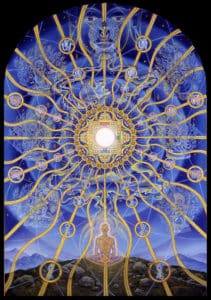
10 Benefits of Conscious Dreamwork
In addition to the spiritual benefits that Dream Yogis can receive through the practice of Dream Yoga, there are numerous personal benefits you can receive as well. Here are some of them:
- Cultivate your innate intuitive abilities
- Discover more freedom of being
- Uncover hidden gifts and potential
- Overcome fears, gain confidence
- Heal past trauma
- Deep emotional release
- Resolve unresolved dramas with other people
- Help you solve problems in a non-logical, non-linear way
- Prepare you for death, the afterlife & the unexpected
- Increase your ability to change your reality and manifest what you want
Dreams can be altered through will and intention. They are a powerful metaphor for life and our experience of reality. The Tibetan Masters understood that we create our own reality, because everything originates in the mind, our experience arises from our own consciousness. If you can change your mind, you can change your reality. Just like changing your dreams.
4 Easy Ways to Have More Lucid Dreams
There are a number of things you can do that will help you have more lucid dreams.
1. Take Dreaming Herbs. There numerous herbs and supplements that enhance dreaming, that can easily be researched online. I don’t want to turn this already long article into a book, so I will share my favorite herbal blend for dreaming – mugwort and marijuana. I like to smoke this blend, because I prefer to avoid using tobacco in my spliffs. My smoking blend tends to have these organic herbs in it:
- Marijuana
- Damiana
- Sage
- Mugwort
- Lavender
- Mullein (if I want to cut tobacco cravings)
Not only is this smoking blend relaxing, the mugwort and marijuana combo makes your dreams more vivid and more colorful. Lavender is fragrant and relaxing. Sage is used for healing and purifying your auric field. The damiana provides a mood uplift and is used in magic for astral travel. Mullein has a history of use as a dreaming herb as well, primarily to ward off bad dreams, or for prophetic dreaming.
If you are not into smoking, this blend can easily be made into a tea and drunk before bedtime.
2. Do Dream Recollection & Journaling. It’s important to do this first thing in the morning, ideally in a physical dream journal rather than on a laptop, because by the time you get out of bed and fire up your computer, your dream may have already faded. Dream journaling strengthens your dreaming skills because
- It increases your dream recall
- As you train yourself to remember dreams, lucid dreams will become more vivid
- As you log your dreams, you will start to notice patterns, like recurring symbols and signs
- Your journal will help you decode the dream signs and symbols and understand what they mean to you.
- Recurring dream signs & symbols can be leveraged as lucid dream anchors, reminders that you are dreaming the next time one appears
3. Listen to Binaural Beats for Lucid Dreaming. Binaural beats are a kind of brain entrainment technology that uses audio to stimulate and change your brain state. The audio is delivered as 2 different pure-tone sine waves, with frequencies lower than 1500 Hz, with less than a 40 Hz difference between them. The 2 audio tones are presented to a listener dichotically (one through each ear) in an oscillating fashion. The oscillating frequencies create an auditory illusion that causes the brain to perceive a third tone based on the mathematical difference between the two frequencies.
These binaural beats can entrain the brain to enter different brainwave states, depending on their frequency or HZ (hertz). These brainwave states are conducive towards achieving different states of consciousness, states that take longer and more practice to achieve using traditional methods. Binaural beats can help you quickly enter into a meditative state, relax, have greater mental clarity, more confidence, and even lucid dream.
Theta waves are the brainwaves associated with dreaming, light sleep, deep relaxation, profound relaxation and calm. Delta waves (0.5-4HZ), by contrast, are the brainwave frequency you have when you are in very deep sleep. The best brainwave state for lucid dreaming is the Theta stage, which is 4HZ-8HZ.
You can find a number of Theta wave binaural beat meditation tracks online. Find one you like and listen to it as you drift off to sleep.
4. Practice Dream Yoga. I mean this in a broader sense than the traditional Tibetan Dream Yoga, are any practices you can do as you are falling asleep, waking up, or in the dream state itself. Here are 2 of my favorite dream yoga techniques.
-
- Look At Your Dream Hands. A dream yoga technique that has worked well for me is described in Carlos Castenada’s book, the Art of Dreaming, which unleashed a spate of surreal lucid dreams when I began reading it. Don Juan tells Castenada to look remember to look at his hands in his dreams. I practiced the looking at my hands technique, not only did it totally work for me, my hands appeared to glow with a green, electric energy. Then I’d become lucid, and try to fly.However, my ability to navigate lucid dreams shifted to a new level of sophistication when I began my formal study and practice of ancient art of Tibetan Dream Yoga. The Tibetan Masters have thoroughly plumbed the depths of non-ordinary consciousness, mapped numerous spiritual realms, and documented what you can, ought to, and should not do there for at least 1000 years.
- Visualize the Seed Syllable “A”. In Tibetan Dream Yoga, the chakra that governs dreaming is the throat chakra, which is related to communication. The symbol of that chakra is Tibetan seed syllable “a”. When ringed by a rainbow “tigle” it is the symbol for Dzogchen, the Great Perfection, a tradition of teachings oriented towards recognition of and abiding in the Nature of Mind, the natural primordial state of being. In order for your conscious awareness to transition from waking to dreaming without interruption, practice visualizing the Tibetan seed syllable “a” (pictured below) in the center of your through, in a glowing red ball of light. Focus your attention on the color, the sound of “aaaahhhh”, and if you are good, the actual symbol itself.
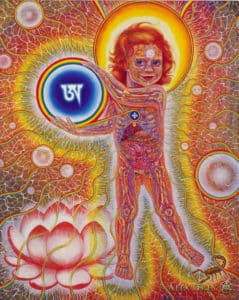
Tibetan Dream Yoga Practice
Life is but a dream, and the purpose of spiritual practice is to awaken from the dream and recognize our true, divine nature. Tibetan Dream Yoga includes wakeup, daytime and nighttime practices so that you train your mind on recognizing the dreamlike quality of human existence.
- Wakeup practices help you recall your dreams, allowing you to remember more of them, in greater detail.
- Daytime practices help you recognize the dreamlike nature of all existence, enabling you to dissolve the barrier between the dream of life and the sleeping dream. This strengthens your ability to experience the dreamstate as vividly as the waking state, while reminding you of the illusory, impermanent nature of all sensory phenomena.
- Nighttime practices help you develop the skill of lucid dreaming, so you can accelerate your spiritual development.
Daytime Dream Yoga Meditation Practices
Contemplate these 4 truths about the illusory nature of all phenomena.
- Yourself. Contemplate the body as illusory and unreal. Your physical body is constantly changing, cells renew and die, eventually you will grow old, die, and your corpse will disintegrate. Your physical body will cease to be. When your physical body ceases to be, what happens to “I”?
- Your thoughts. Contemplate the mind and mental activities as similarly insubstantial. Like clouds in the sky, thoughts and emotions arise, dissolve, and disappear.
- The world. All life is born, grows old, and dies. All physical objects eventually decay and dissolve. Recognize the world and all tangible phenomena and experience as dreamlike, insubstantial, impermanent, and unreal.
- All intangible phenomena. Our existence is governed by numerous intangible forces that elude the grasping, analytical nature of our ordinary minds. Experience of this intangible phenomena is also relative to the organism that you are and the consciousness you have. Recognize the relativity and ungraspable quality such as time, space, gravity, knowledge, and awareness.
The practice of contemplating these four truths throughout our waking hours helps to dissolve the barrier between the dream of life and the sleeping dream. This allows us to recognize that our nighttime dreams are a continuation of our waking dream, and we learn to bring habitual awareness to both.
Nighttime Dream Yoga Meditation Practices
As you go to sleep at night, lie flat on your back with your spine straight, and your arms on either side of your body in corpse posture.
- Contemplate the illusory nature of all phenomena, in order to create the conditions for mindful, lucid dreaming.
- Dedicate your practice. To strengthen your resolve to awaken within the dream, recite this prayer dedicating your dream practice towards the awakening of all beings 3 times:
“May I awaken within this dream and grasp the fact that I am dreaming, so that all dreamlike beings may likewise awaken from the nightmare of illusory suffering and confusion.” - Visualize the seed syllable “a” in your throat chakra, surrounding by a soft red light. Associate the symbol with the sound “ahhh”. Keep your awareness on it while you are falling asleep.
This chakra visualization practice will enable you to maintain awareness of Ground Luminosity, (also known as Clear Light in the Dzogchen tradition, both while dreaming and while deeply asleep). It is the light of Universal Consciousness, the pure radiance of simple wakefulness.
Dream Yoga Wake-up Practice
The best time to recall your dreams is immediately after waking. It’s best to remain still in bed, for a few minutes, to allow your mind to recall your dream experiences. When you feel like you’ve remembered everything you could about your last night’s dream, start the day with the following pranayama yoga practice to support and strengthen your dream recall abilities:
- Begin with Simhasana (the lion’s out-breath), breathing out with the sound “ah”, while sticking out your tongue as far as it will go
- Then, assume Lion’s Pose for awakening and purifying – sitting up in bed with raised head and gazing and emphasizing the exhalation, repeating the “ah” out breath three times
- Next, step out of bed, raising your energy by standing up, reaching the fingertips to the sky, and repeating the lion’s out-breath
With mindful reflection on the transition between the states of sleeping, dreaming, and waking reality, come into the present moment to record your dreams in your dream journal. Thus, you start the day recognizing the illusory nature of all phenomena.
Here’s how to do Lion’s Breath
Why Lucid Dreaming Is a Powerful Shamanic Practice
Anyone who has experienced lucid dreams and plant medicine ceremonies will notice the similarities and differences between the dream state, and shamanic visions. You can have a lot of similar experiences in each state, though those experiences tend to feel much stronger in the visionary state. But the dreamstate and visionary state has key distinctions, largely around what you are capable of doing in each state.
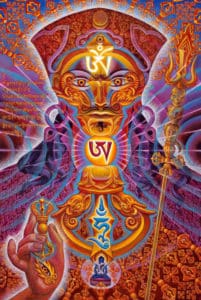
The Difference between Shamanic Visions & Lucid Dreams
Shamanic visions, especially those received in sacred plant medicine ceremony, tend to be much more directly attuned with information coming from spiritual realms, because you are in an expanded state of consciousness. And if you purged, in addition to clearing your body temple, chances are, emotional, mental, and other subconscious junk got cleared out along with the vomit. So whatever visions, downloads, and spirit world journeys are experienced in a much clearer and more powerful way.
Shamanic visions also tend to “unfold”, with the journeyer being taken along for the ride, like a boat on a river. The more open your mind is, the more incredible visions can come through. Unlike dreams, shamanic visions tend to have more visual consistency, in that some of the realms you visit can seem remarkably real, in landscape and architecture. Versus a dream, where you are naked, at the office, surrounded by coworkers, and your boss has turned into a giraffe. And now that you are lucid, it’s time to fly out of the window and get away from all of that.
Dreams tend to be considerably more surreal and filled with noise ejected by your subconscious as it processes your day-to-day experience. It can be more challenging to determine what is a divine signal, and what is subconscious noise.
However, dreams can be radically altered through will and intention. They are a powerful metaphor for life and our experience of reality, so the mastery of subtle art of dreamstate navigation and dreamscape transformation is an excellent shamanic skill.
The primary difference between lucid dreaming and shamanic visions is what you can change and how you can change it. Dreams are much more easily altered at will, while it’s difficult to change or modify an ayahuasca vision. The sacred medicines will show you what THEY think you need to see.
The main thing you can change in a plant medicine vision is yourself, primarily through shapeshifting. You can also change your location, but not in the way this works in the dreamstate.
Too much mental focus and hardness of concentration tends to make a shamanic vision dissipate. Or result in a “contrived” vision, largely directed by your conscious mind. Because of this quality, a lot of the lucid dreaming techniques may be difficult to apply to a shamanic journey.
In a similar way, too much mental focus can wake you up out of a lucid dream. In either scenario, conscious navigation of dream states and visionary states is a subtle art that balances your capacity to maintain a wide open consciousness, with a dash of intention. However, mastery of these subtle states of consciousness will make you a master navigator of dreamstates, the Spirit World, and waking life.
The Tibetan Masters understood that we create our own reality, because everything originates in the mind, our experience arises from our own consciousness. If you can change your mind, you can change your reality. Just like changing your dreams.
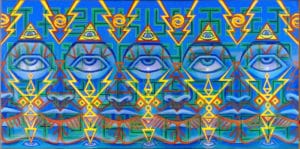
Your Shamanic Dream Yoga Journal
Keeping a dream journal will help you discover the patterns and recurring themes in your dream, and decode the messages the Universe has for you, hidden in the symbolic language of your subconscious mind. When you identify recurring dream signs, you can also use them as lucid dreaming anchors, so that the next time you see the sign, it reminds you that you are dreaming.
DATE: ______________________ LUCID: YES/NO
NAME YOUR DREAM: ________________________________________________________________________________________
IF LUCID, WHAT CAUSED IT: _________________________________________________________________________________
What happened in your dream?
Write down everything you can remember in the present tense to bring you back to the moment.
Identify the dream themes, especially if they are recurring dream themes.
What repetitive themes, scenes, symbols or images come up for you in your visions and dreams? Which people, guides, teachers, spirits, ancestors, relations and friends show up repeatedly in your visions and dreams? Pay special attention to any emotional responses that arose for you, in addition what you saw in the dream.
Draw anything of significance that appeared for you in the dream, especially symbols and words.
Don’t worry if it isn’t art, this is to help you with dream recall. Note anything that strikes you about the dream sign.
What major life issues are going on for you right now?
Do you see any relationship with your life issues and your dream themes? This tends to become more clear over time.
What parallel themes appear in your shamanic journeys?
Do you see any relationship with your dream themes and your shamanic journeys?
Dream Yoga & Lucid Dreaming Resources
My favorite book on the topic is Tibetan Yogas of Dream and Sleep by my Teacher Tenzin Wangyal Rinpoche. I attended a number of Dream Yoga retreats with him as well.
The Tibetan Yogas of Dream & Sleep by Tenzin Wangyal Rinpoche
Dream Yoga: The Practice of Lucid Dreaming as a Path to Enlightenment by Tenzin Wangyal Rinpoche
Dream Yoga and the Practice of Natural Light by Namkhai Norbu
Tibetan Dream Yoga Audio CD by Lama Surya Das
Amazing Visionary Art by Alex Grey
